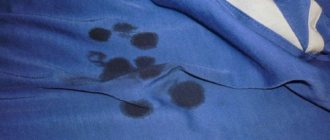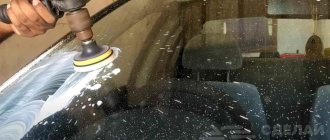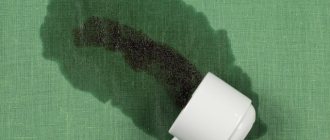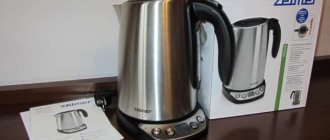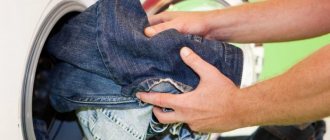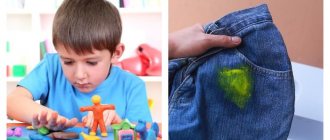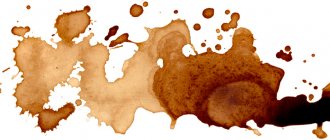Recommendations for removing grease stains from clothes.
Every person at least once in his life has had to deal with greasy stains on his clothes. And since such contaminants are difficult to remove, sometimes you have to spend a lot of time and effort to combat them. The most unpleasant thing in this case is that if you do not remove the stain as quickly as possible, it will become embedded in the fabric, and it is likely that the item will have to be thrown away.
To prevent your favorite clothes from suffering the same fate, we will teach you how to properly deal with greasy stains from butter, vegetable oil, machine oil and massage oil.
How and with what to remove old machine and vegetable oil stains from clothes: recipes
Removing old stains from machine and vegetable oil from clothes: recipes
As practice shows, old stains are more difficult to remove from clothes than fresh ones, but still, in this case you can revive a seemingly completely damaged item. The only thing you must remember is that old stains should never be subjected to heat treatment. Since the fat in this case is already well ingrained into the material, the high temperature will only fix it there even more.
For this reason, things with old grease stains should never be ironed, steamed or washed in hot water. Therefore, it will be better if you try to treat the contaminated material with substances that will destroy the fat molecules and help them to easily separate from the fibers of the material.
Ammonia and glycerin
- Take equal parts of water, ammonia and glycerin, and beat them until smooth.
- Next, soak a piece of gauze in the resulting liquid and thoroughly wipe the greasy stain with it.
- If the stain is more than 2 weeks old, then additionally soak a cotton pad in the cleaning liquid and apply it to the stain.
- Leave the item to sit for 1.5 hours
- Once the time is up, rinse it and repeat the procedure if necessary.
- As a rule, after the second time the oldest stains disappear
- Once the fabric is free of grease, be sure to wash it in the standard way.
Salt and detergent
- Dissolve 2 tbsp. l salt in 30 ml water
- Add 15 ml of any dishwashing detergent to the saline solution
- Lightly foam the liquid and use a soft sponge to treat the greasy stain.
- Soak a piece of gauze in the cleaning product and cover the dirty area with it.
- Leave everything to sit for 50 minutes, and then rinse thoroughly with water and be sure to wash it additionally.
Dishwashing detergent
Fairy, AOC, Drop, Sorti - this is an incomplete list of washing shampoos developed by modern chemists to make work easier in the household.
Their main purpose is the breakdown of organic compounds even in cold water. These products are suitable not only for their intended purpose, but also for removing many fatty deposits.
To clean an oil stain you need:
- Apply washing shampoo to the dirty area and rub into the fabric. The measure of acidity - pH - of such preparations is neutral or slightly alkaline, so there will be no harm to clothing. If the material is still delicate, then try first on the wrong side of the seam;
- Pour water into a small container and wash the item;
- Rinse and dry.
Important! Do not use special grease cleaners for ovens and grills. The nature of the action of the drugs is very aggressive and dangerous for the integrity of even the most resistant paints and fabrics.
How and with what to remove oil stains from jeans?
Toothpaste for cleaning jeans
Since denim material has a fairly rough structure, it is necessary to deal with greasy stains that appear on it very quickly. If you miss the moment, the fat will become so deeply embedded in the threads that you can only get rid of it with the help of very strong fat-dissolving agents.
One of these is gasoline. And although it fights such stains very well, this cleaning method has one big disadvantage. After removing the stain, you will have to wash the item several times to remove the smell of this petroleum product.
Toothpaste or tooth powder
Since these products cope equally well with greasy stains, you can easily take exactly what you have on hand. Just remember, if it is tooth powder, it will need to be diluted with water. In principle, at the initial stage you can use dry. But you will only need to apply it to the stain for 15-20 minutes and then remove it immediately.
Subsequently, you will still need to prepare a liquid paste and fight the stain with it. Also, do not forget that these products dry out very quickly and become covered with a hard crust. In view of this, they must be covered with a damp cloth or simply sprayed periodically from a spray bottle.
So:
- Take toothpaste and apply a thick layer to the greasy stain
- Leave it on the fabric for 30 minutes, remembering to moisten it periodically
- After the time has passed, remove everything with a scraper or knife and wash the jeans in warm water with the addition of a soap base.
Ordinary chalk
- If the stain is fresh, you can quite easily sprinkle it with chalk, cover it with paper and put it under a press
- The stain should remain under pressure for at least an hour.
- During this time, the chalk will absorb the grease and all you have to do is wash your jeans using any soap solution
Table salt for purifying sunflower oil
An easily accessible product that no housewife or catering establishment can do without. It is best to use finely ground “Extra” salt. It easily penetrates the pores of soiled clothing, absorbing oily substances.
The effect may be even better if you place a paper napkin or towel on top of the small crystals and iron it. Salt is chemically neutral, so it will not damage your item upon contact.
How and with what to remove an oil stain from a jacket?
Cleaning agent for fabric jackets
In the case of a jacket, you must take into account what fabric it is made from. After all, the thicker and denser it is, the more powerful the product will need to be used. As for outerwear made from thin fabrics, in most cases, greasy stains are removed from them using ordinary washing. Provided, of course, that the contamination was not old.
Yes, and remember that in this case it is better not to carry out preliminary grouting or washing, but rather to immediately begin removing the greasy stain. Since all jackets have a synthetic padding lining, such measures will help the fat seep onto the insulation, and this will further aggravate your little problem.
Product for leather jackets
- Take 50 g of starch and mix it with 20 ml of gasoline
- Apply the resulting paste onto the stain.
- Leave the product on the skin until it is completely dry
- Once this happens, take an old toothbrush and carefully remove the product
- At the final stage, simply wipe everything with a cloth soaked in soapy water
Product for fabric jackets
- To prepare this fat-dissolving liquid you will need washing powder, ammonia and warm water.
- So, heat 70 ml of water and dissolve 50 g of washing powder in it
- Add 35 drops of ammonia to the soap solution and mix everything again
- Apply it to the dirty area and cover with a damp cloth
- Leave it there for 1 hour and then wash the jacket in the washing machine
Useful tips
For cleaning to be successful, you should follow several recommendations:
When using the brush, use gentle movements, otherwise you will damage the fabric. A hard brush is only suitable for dense fabrics.
Not all stain removers are aimed at removing greasy stains - this factor should be taken into account when purchasing it.
If you are unable to remove an oil stain from your clothing, use dry cleaning services.
How and with what to remove oil stains from delicate fabrics?
Detergent for cleaning delicate fabrics
As for delicate fabrics, they must be cleaned with the utmost care. Since mechanical impact is strictly contraindicated for them, it is undesirable to rub them even with a soft foam sponge. In view of this, if you do not want to completely ruin the item, then try to treat stains with products that remove all dirt without any additional action.
For example, natural silk is best tidied up using a product made from ammonia and glycerin. If you take these two substances in equal parts, mix and apply to the stain, then after 20 minutes there will be no trace left of it.
Saline solution
This product is perfect for removing stains from white or light-colored fabrics. If you soak the entire thing in it, you will not only get rid of dirt but also whiten it.
So:
- Boil 1 liter of water and dissolve 1 cup of salt in it
- Let the liquid cool to room temperature, and then soak the stain or the entire item in it.
- Let it sit in the solution for 2 hours, then wring it out, rinse in clean water and can be washed in the standard way.
Lemon-onion solution
Lemon-onion solution
In this case, before use, you must check how the fabric will react to lemon juice. To do this, you will need to apply it to the corner from the wrong side and see if the color changes in this area. If after 30 minutes the treated area remains the same as it was, you can safely use the product to clean your favorite item.
So:
- Take 1 large onion and use a blender to puree it
- Add the juice of one lemon to it and mix everything thoroughly
- Apply the product to the stain and leave for 40 minutes
- Rinse off residue with clean water and be sure to wash
Soda solution
- Take a small amount of baking soda and dilute it with water until it turns into a paste.
- Apply the product to the stain and cover it with a damp cloth
- Leave it on the soil for 1 hour, and then rinse it in water with added gel for washing delicate items.
Baking soda for cleaning sunflower oil
It has a weak alkaline reaction, breaking down and adsorbing sunflower oil. To remove stains, sprinkle the powder onto the surface and rub thoroughly into the fabric with a brush. 20-30 minutes is enough to clean the material.
Natural suede is subjected to this procedure, and bulky pile carpets are washed perfectly. A similar result will be obtained when using tooth powder containing chalk instead of soda.
What stain removers are there for machine and vegetable oil from clothes: how to use them?
List of effective stain removers
If you are afraid to experiment or are simply too lazy to prepare cleaning products, you can always try to get rid of the problem using ready-made stain removers. At the moment, in any specialized department you can find similar household chemicals of good quality. For those who have never purchased such products, we offer a list of the most effective stain removers at an average cost.
So:
- Frau Schmidt . Made on the basis of bile soap, which has a gentle effect on fabric fibers and, most importantly, does not irritate the delicate skin of the hands. It is applied to the stain in its pure form, left for 1.5-2 hours and then carried out a standard wash.
- Ecover. Since this product is made on the basis of plant components and minerals, it can be safely used to remove stains from delicate fabrics. Apply a thin layer of the product to the stain 20 minutes before washing. Before putting the item in the washing machine, you will definitely need to rub it with a brush, which is sold complete with household chemicals.
- Udalix Ultra. Sold in powder, gel and stick form. Used in the standard way. The product is applied to the dirt and then cleaned with water.
Immediate cleaning actions
Let's use what we have, first checking the affected fabric for tolerance to certain cleaning substances. Table salt – sprinkle generously on the stain, gently rub it into the clothes and leave for 5-10 minutes. You can use paper napkins.
Laundry soap works well. To do this you need:
- Pour hot or warm (depending on the composition of the fabric) water into the basin;
- Gently soap the contaminated area;
- Leave to unlock for 2-3 hours;
- Wash in a washing machine.
It will be more difficult if you find yourself visiting, traveling or in a public place. The experience accumulated by more than one generation will help here. Let's try to look at some effective folk methods for removing oil stains.
Gasoline, benzene, turpentine
To use these solvents, you first need to make a test on the lining or back of the garment. Cotton, linen items or those containing a small percentage of synthetics must be cleaned. The most effective work will be done when potato starch is added to the solvents.
Important! Do not use motor gasoline to remove contaminants. Numerous toxic additives make the fuel itself difficult to remove from any fabric.
For this purpose, you should purchase well-refined gasoline, kerosene or turpentine at hardware stores. Cleaning algorithm:
place a piece of cotton textile or paper towel under the stain;
- Moisten a clean cloth with solvent;
- Wipe the dirty area with a damp cloth from the edges to the center;
- Treat the rim that has formed as it dries with a swab dipped in gasoline.
What can you do first?
Once the oil gets on the item, the main task is to prevent it from spreading. To do this, remove as much as possible: blot with a napkin, then sprinkle with any adsorbent (absorber).
Salt
Sprinkle generously in a thick layer and rub in gently. Remove after 10-20 minutes. If the mark does not disappear, repeat until you get the result.
Dish detergent
Any concentrate will do, since each contains components that break down fats. They pour it over the dirt and keep it for 15-30 minutes when it’s fresh, and longer when it’s dried. If the item can be washed, put it in the washing machine; if not, remove the gel with a damp cloth.
Dentifrice
Sprinkle the oil trail and rub in a little. Leave for 15-20 minutes, brush off, wash clothes. Apply a mixture of powder and water to the dried stain. Leave for 2-3 hours, then remove and wash the product.
Shaving foam
Shake the bottle and spray the foam onto the stained area. Wait 20-30 minutes, remove any residue, wipe the product with a damp cloth or wash it. If necessary, repeat the procedure.
Carpet cleaning
What to do if insidious oil spills on your favorite piece of furniture? First, blot the excess product dry with paper towels.
Next, laundry soap and washing powder will be used:
- Place a piece of polyethylene under the carpet, and then any clean cloth to avoid damage to the floor covering;
- Moisten the surface of the dirty layer and a little around it with water so that the stain does not increase;
- Take a stiff brush, soap it or add a little powder;
- Rub the detergent into the pile;
- Rinse and blot the clean item with a dry cloth.
Some Caveats
It is much easier to remove fresh dirt from the surface than dried and crusted dirt.
When working with any fabric, do a test test on the wrong side of the seam or hem of the fabric. Be careful with delicate material.
Do not use plumbing cleaners. They are too aggressive.
When using stain removers, carefully read the instructions - the chlorine they contain will permanently ruin any item.
When working with solvents - gasoline, turpentine, ammonia, use hand protection and do not forget to open the windows.
